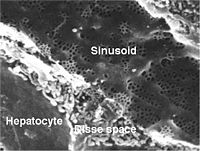
Photo from wikipedia
The pancreas and liver are closely related developmentally and trans-differentiation of cells from one tissue into the cells of the other has been documented to occur after injury or exposure… Click to show full abstract
The pancreas and liver are closely related developmentally and trans-differentiation of cells from one tissue into the cells of the other has been documented to occur after injury or exposure to selected growth factors or glucocorticoid hormones. To generate a readily-expandable source of human hepatocyte-like (H-13) cells, the human pancreatic adenocarcinoma cell (HPAC) line was stably transfected with a construct encoding the variant 2 hepatocyte nuclear factor 4 α (HNF4α) using a piggyBac vector and transient expression of a transposase. Through induction of transgene HNF4α regulated via an upstream glucocorticoid response element in combination with existing modulating effects of glucocorticoid, H-13 cells were converted into quantitatively similar hepatocyte-like (H-13/H) cells based on expression of a variety of hepatocyte proteins. H-13/H cells also demonstrated the ability to store glycogen and lipids. These data provide proof of concept that regulated expression of genes associated with hepatocyte phenotype could be used to generate quantitatively functional human hepatocyte-like cells using a readily expandable cell source and simple culture protocol. This approach would have utility in Toxicology and Hepatology research.
Journal Title: Biochemical and biophysical research communications
Year Published: 2018
Link to full text (if available)
Share on Social Media: Sign Up to like & get
recommendations!